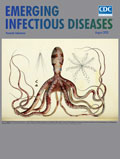
Volume 26, Number 8—August 2020
Synopsis
Epidemiology of Legionnaires’ Disease, Hong Kong, China, 2005−2015
Abstract
We reviewed findings of clinical, epidemiologic, and environmental investigations for 288 confirmed case-patients with Legionnaires’ disease reported in Hong Kong, China, during January 2005−December 2015. We found that chronic renal failure/impairment (adjusted odds ratio [aOR] 4.09), chronic pulmonary diseases (aOR 3.22), malignancy (aOR 3.04), and heart diseases (aOR 2.15) were independently associated with a higher risk for severe Legionnaires’ disease. However, patients with hyperlipidemia had a lower risk for severe outcome (aOR 0.17). Legionella positivity rate was 22% for 1,904 water samples collected. We found a higher positivity rate in summer months (28%−30%), which corroborated with months of highest rainfalls. Our novel finding that Legionnaires’ disease patients with hyperlipidemia had a lower risk for severe outcome deserves further study to confirm the observation and ascertain the underlying reason.
Legionnaires’ disease is caused by bacteria of the species Legionella, of which Legionella pneumophila serogroup 1 (Lp1) is the most virulent and the most common cause of disease (1). Legionnaires’ disease is transmitted mainly by inhalation of infectious aerosols; microaspiration of contaminated water is another possible mode of transmission (2,3).
Aerosol-generating systems, including cooling towers, whirlpools, decorative fountains, humidifiers or respiratory equipment, have been linked to Legionnaires’ disease cases and outbreaks (4,5). In particular, cooling towers are the most commonly reported source of infection for Legionnaires’ disease outbreaks, and hundreds of persons were affected in some outbreaks (5,6).
In Hong Kong, Legionnaires’ disease has been a notifiable infectious disease since 1994. Medical practitioners are required by law to report suspected or confirmed cases to the Centre for Health Protection (CHP) of the Department of Health. A confirmed case is defined as illness in a patient who had pneumonia and confirmatory laboratory results, including detection of Lp1 antigen in urine, detection of Legionella species nucleic acid or culture positive for Legionella species in respiratory specimens, or demonstration of a >4-fold increase in antibody titer against L. pneumophila in paired serum specimens. In this study, we reviewed the clinical, epidemiologic and environmental investigation findings for all confirmed Legionnaires’ disease cases reported during January 2005–December 2015.






















.png)











No hay comentarios:
Publicar un comentario